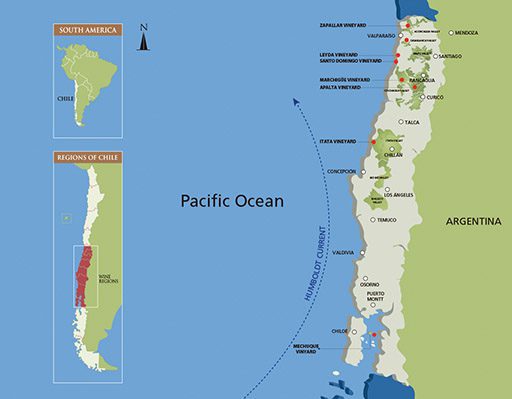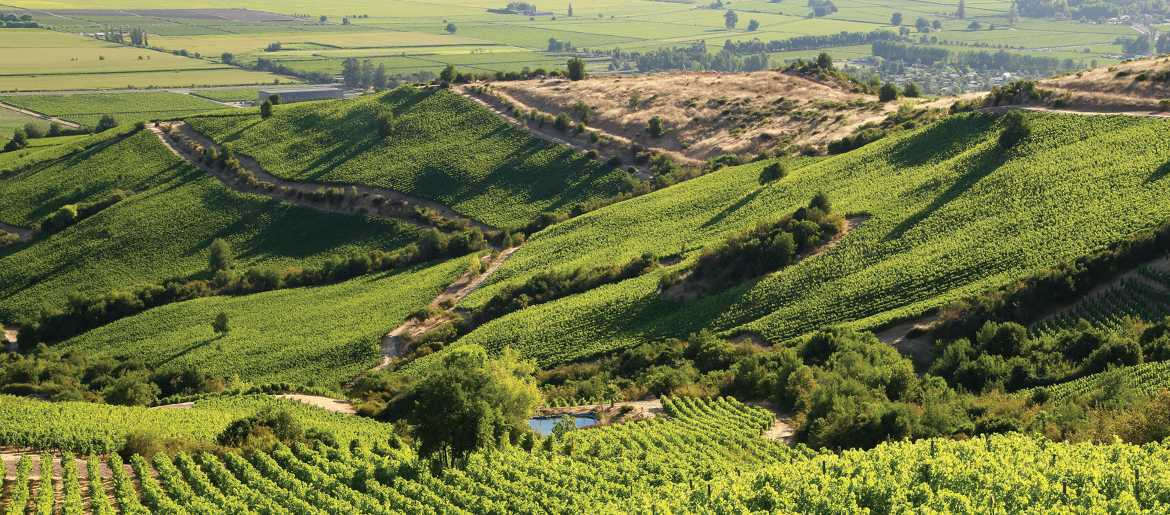Chile is known for its red wines, but a combination of geography, terroir, and altitude help make it a stand-out country for whites, as well. Read on to discover more about Chilean white wine and what to be on the lookout for.
One of the biggest problems in the New World is that sometimes producers plant white grapes in appellations that are too hot for them, so they end up getting overripe fruit and sometimes “flabby” wine. This is not the case of Chile, which was blessed with a combination of maritime and alpine influences that made it possible for them to produce fantastic whites in several of their appellations.
To make white wines with elegance and finesse, we need plenty of sun and dry weather paired with cool to moderate temperatures. This allows grapes to develop their fruit flavors slowly while keeping their refreshing acidity.
Chilean Geography: Long, Narrow, with Lots of Ocean Breezes
Chile is a very narrow, long country that extends for 2600 miles, lined with coastal regions north to south. These coastal regions are influenced by the cooling Pacific Humboldt current, which provides breezes, fogs, and even salty/iodine notes. This similar phenomenon happens also in California, especially in the appellations closer to San Pablo’s Bay.
Besides the cool Pacific Ocean influence, Chile has an alpine influence, with temperatures decreasing as we ascend the mountains. There are two important mountain systems: one is the Entre Cordilleras or Coastal Range (this mountain system is located between the Pacific Ocean and the Andes), and the other is the Andes themselves, where altitudes may reach up to 13,000 feet. Finally, white wine is also produced in southern Chile, which is naturally cooler.

What to Expect from Chilean White Wines
Wine drinkers usually know Chile for its red wines, but 36% of their production is white. The most important Chilean white wine varieties are:
- Sauvignon Blanc
- Chardonnay
- Muscat or Moscatel
- Riesling
The style of Chilean Sauvignon Blanc is very much from the New World: more fruity and less mineral, closer to New Zealand’s style than that of the Loire Valley (whose wines are very mineral). These are medium-bodied wines with plenty of acidity, fresh citrus (grapefruit, lime), passion fruit, and green pepper flavors. A great example is the Montes Classic Sauvignon Blanc: The nose is intense and cheerful (as NZ’s Sauvignon Blancs often are). Aromas of lime and yellow grapefruit are accompanied by attractive notes of fresh pineapples, passion fruit, and orange blossom.
Chardonnays are made in the Burgundy style, and like in Burgundy, Chile has plenty of limestone soils, so the styles vary from mineral, citrusy, and elegant similar to Chablis to rounder and fat, featuring pear, apricots, and pineapple notes with a touch of oak and in some cases aging on its lees, similar to the Côte d’Or Burgundies. Chardonnay is also used to produce sparkling wines. Here, a good example is the Montes Classic Chardonnay. Coming from the Casablanca and Curico Valleys (more on this below!), it blends cool climate citrus and floral notes from Casablance with the warmer Curico Valley notes of tropical pineapple, peaches, and apricots.

Chilean Wine Regions
Following this map from Wines of Chile, our tour of the appellations should start in the north, where we find the Huasco Costa and Huasco Alta appellations. Here, fine samples of mineral-driven Chardonnay are produced, as well as elegant Sauvignon Blancs and Pajarete, which is a sweet and aromatic wine made from a blend of Moscatel grapes.
Continuing south, we find the Elqui and Limarí valleys, both regions influenced by the Pacific breezes. Elqui is known for its distinctive style of Sauvignon Blanc, while Limarí , also known as Chile’s green north, specializes in Chardonnay.
Then come the important white wine appellations: Casablanca Valley, located about 60 miles west from Santiago, where the Chilean cool climate wine revolution started in the 1980s led by Pablo Morandé, the San Antonio and the Leyda Valleys, located about 70 miles southwest from Santiago. All three produce racy Sauvignon Blancs that showcase minerality, citrus, and tropical fruits and Chardonnay from vines that grow on granitic, sand, and limestone soils.
Further south, Sauvignon Blanc has found a home in the Curicó valley, an appellation that attracted investors like famous winemaker Miguel Torres. The Alto Maule is also known for its award winning Sauvignon Blancs, though Maule doesn’t have any maritime influence; rather, it is affected by the alpine influence from the Andes.
Finally, in the south, we find regions like the Bío Bío, Malleco, and Osorno Valleys, where the protective effects of the coastal range are felt less. These regions are cooler and wetter, producing fabulous Sauvignon Blancs, Chardonnays, and Rieslings grown in volcanic and sandy soils.





